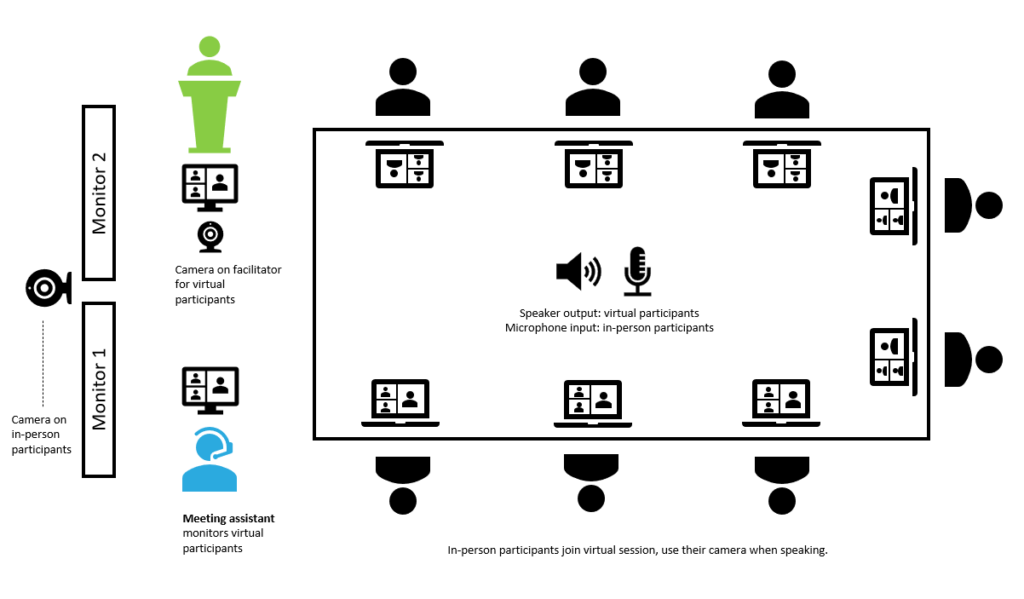As businesses transition back to in-office work, a shift to hybrid meetings is underway, where some people attend in person and others attend virtually.
For larger and more complex facilitated workshops that require strong participant engagement and collaboration such as PDRI assessments, Construction Readiness assessments and Risk workshops, a hybrid meeting is much more difficult to successfully execute than a fully in-person or fully virtual format.
Remote participants are only one slip-up away from losing that first-class status3.
– Harvard Business Review, 2021
Balancing group dynamics is very challenging with multiple modes of communication – especially if there is poor audio quality. In addition, the mental load on the facilitator is very high as they work to track verbal and non-verbal cues, promote engagement and ensure the group achieves meeting objectives1.
When planning a complex facilitated workshop, consider if it’s feasible to have the entire meeting either virtually or in-person. This is a proven strategy to ensure all participants are on an even playing field and keep the focus on the meeting objectives.2 If this is not feasible and a hybrid format is necessary, we’ve compiled these tips from our experience in leading complex facilitated workshops.
Key Factors for Productive Hybrid Meetings
There are three key factors that contribute to a successful facilitated hybrid meeting:
- Planning & Agenda
- Have an Assistant
- Meeting Room Setup
Planning your Hybrid Meeting
Your primary challenge in planning a hybrid meeting is to ensure everyone can easily participate and focus on accomplishing the objectives of the meeting. The first step to achieving this is to have a clear breakdown of:
- Meeting topics, their desired outcome and the activities that will best support the desired outcome (process) and timeframe
- Participants, their roles & responsibilities as it relates to the objective of the meeting, make sure they understand expectations
- Room set up requirements (virtual and physical). Create an even playing field for all participants. This means making sure that those joining remotely have as good an experience as those attending in-person and vice versa.
Increase the time you budget for planning. You are essentially organizing two meetings (virtual and in-person). There is additional time required for setup of any collaboration tools you might use to support meeting deliverables. You’ll also want to include time for test runs to ensure your collaboration tools run smoothly for both in-person and virtual participants.
Agendas for Hybrid Meetings
When developing the agenda, it’s important to budget extra time for:
Participant orientation
- Introduce the meeting structure
- What will be shown on screen(s)
- How the agenda will be executed
- Tools that will be used
- Facilitator and assistant/scribe responsibilities
- Educate attendees about how they can participate
- Chat – who is running the chat, etc.
- Raising their hand – physical and in person
- Unmuting and speaking
Participant introductions and icebreaker
- Providing a seating plan or visual orientation of where each attendee is helps everyone engage with each other and follow the flow of communications.
Questions and clarifications
- By nature, a hybrid meeting requires clear lines of communication and that often means stating the obvious, asking more questions and clarifying what was said so that everyone hears and understands the conversation.
Transitions between meeting topics
- As you move from one agenda item to the next, it isn’t always be obvious to everyone what is happening. Make a point of introducing the next topic and the method of collaboration that will be used, for instance, will the facilitator be:
- Going around the room and ask for input from each person?
- Leading an informal discussion where anyone can raise their hand and contribute?
- Calling on specific people at certain points in time?
- As you transition, it’s important to allow time for participants to access necessary tools (if applicable) so that everyone’s in the same place when you’re ready to begin the exercise.
Breaks
Consider the needs of both participants and the facilitator when planning breaks. Breaks are an important opportunity for the facilitator and assistant(s) to connect and discuss any issues or non-verbal cues that have arisen. Short, frequent breaks also keep your facilitator fresh as they strive to keep engagement high and communication going among all participants.
Have at least one assistant to support the facilitator of a Hybrid Workshop
As the facilitator, your time should be focused on effective engagement of participants. An assistant or scribe can help monitor both the in-person and virtual participants to relay participants that need to be heard, observe body language and non-verbal signals, keep you on schedule and help with technical issues that tend to arise1.
In-Person Room Setup for Hybrid Meetings
Today, the biggest disruptor of a hybrid meeting is poor audio quality. If your virtual participants can’t hear all the in-person participants, communication quickly breaks down and you will spend too much time reiterating and directing conversations instead of accomplishing meeting objectives. Once the in-person meeting room is selected, ensure you perform an advanced audio test. There are multiple cost-effective solutions that can enhance the audio quality for all participants. A quick search for the top-rated conference speaker and microphones will get you started3.
In addition to audio, there are some key considerations for how the meeting should be set-up. A suggested layout for the in-person meeting room can be illustrated as follows:

Key considerations include:
- Speaker and microphone *audio quality is very important*, consider a conference Bluetooth or USB speaker with microphone (google search term)
- Wall with large monitors (ideally 2) to see virtual participants and share screen
- Encourage virtual participants to have their web camera turned on, alternatively use a static photo
- Webcams set up in the conference rooms
- All participants should be able to see the facilitator speaking
- Cameras – wide lens / good quality web camera to capture all in-person participants so that virtual participants can see.
- The facilitator should have a laptop with camera in front of them so that virtual participants can always see them.
- Large boardroom table configured so that all in-person participants can see each other
- Laptop(s)
- The facilitator and assistant are in both the in-person and virtual meeting rooms, with the ability to screen share and monitor chat
- Participants may need to bring their own device depending on the planned activities
- Make sure audio is only coming from one source in the room, keep the other sources off/muted/disconnected).
- Assistants should be prepared to quickly mute in-person participants that forget this step.
It’s important to make sure you are familiar with the technology set-up and thoroughly test everything (in-person and virtual) prior to the meeting to avoid any issues or distractions once your workshop begins.
Tools & Techniques for Hybrid Meetings
There are many ways to encourage communication and engagement during hybrid workshops, the key is to provide strong facilitation3. Below are some of the key points to keep in mind.
Techniques for Hybrid Meetings
Communication
- Make sure you know who is at the meeting and where they are so that you can track participation and call on those who haven’t participated1.
- Plan to call on individuals to speak to different areas of discussion based on their expertise (sometimes this can be determined ahead of time)
- Control the pace of the conversation and be very deliberate about making sure all voices are heard and all questions are answered.
Clarifying
- Be aware that you cannot assume that everyone understands comments that are made. Make a point of clarifying with participants and asking if there are any questions.
- If necessary, read the chat out loud if it’s hard for in-person attendees to see.
Tools for Hybrid Meetings
Keeping participants engaged and encouraging collaboration is key to a productive hybrid meeting. There are some excellent tools available that can support your workshop objectives and provide different ways to promote participation3.
If you traditionally use a white board and sticky notes to capture brainstorming ideas, you can now do this on a virtual white board. In hybrid meetings, always employ a collaboration tool/technique that allows all attendees to participate equally. This may mean that in-person attendees must use a laptop or phone in your workshop.
Making sure any white board templates and polls are prepared ahead of time is very important. It’s also best if you test your layouts in advance to make sure they are readable on the screen for in-person participants.
The easier you can make the experience for all participants the more productive your session will be.
Collecting feedback
Taking a few minutes at the end of your workshop to collect feedback from your participants will help you to continuously improve your execution of hybrid meetings2.
In summary, it is usually more effective to have everyone join a collaborative workshop in-person or virtual rather than a hybrid format. However, when hybrid meetings are required, investing time in planning and preparation will ensure your meeting is more productive and that you meet the objectives of your session.
References
- Facilitating Hybrid Groups Online, Training for Change, https://www.trainingforchange.org/training_tools/facilitating-hybrid-groups-online/
- Considerations and Best Practices for Running Hybrid Meetings, i4cp, https://www.i4cp.com/coronavirus/considerations-and-best-practices-for-running-hybrid-meetings
- What it Takes to Run a Great Hybrid Meeting, Harvard Business Review, https://hbr.org/2021/06/what-it-takes-to-run-a-great-hybrid-meeting

